To optimize your email campaigns with Mailchimp's advanced features, start by utilizing segmentation tools to target specific demographics and engagement levels. Craft compelling subject lines that grab attention and drive open rates. Use Mailchimp's Send Time Optimization to schedule your emails when your audience is most active. Personalize your content to enhance engagement, and don't forget to include clear calls-to-action. Regularly analyze your campaign performance and utilize A/B testing to refine your strategies. By mastering these elements, you'll see better results. Discover even more tips to elevate your campaigns further.
Key Takeaways
- Utilize Mailchimp's advanced segmentation tools to tailor your emails based on demographics and engagement for improved targeting.
- Implement automation features to schedule campaigns and send timely messages, enhancing engagement with your audience.
- Optimize subject lines by keeping them concise, utilizing personalization, and testing different versions to boost open rates.
- Leverage Send Time Optimization to identify the best times to send emails, increasing the chances of engagement.
- Regularly analyze campaign performance metrics and conduct A/B testing to refine strategies and improve overall effectiveness.
Understanding Mailchimp's Core Features

Understanding Mailchimp's core features can greatly enhance your email marketing efforts. Mailchimp offers a user-friendly interface that makes creating attractive emails easy, whether you're tech-savvy or not.
One standout feature is the advanced segmentation tools, which allow you to divide your email lists based on demographics, purchase history, and engagement levels. This means you can send targeted messages that resonate with specific audience segments, markedly improving your email marketing results. By focusing on effective email marketing strategies, you can further refine your campaigns for even better outcomes.
Additionally, Mailchimp's automation features let you create intricate drip email campaigns. You can set these up once and watch them run without having to manually intervene, saving you time and ensuring consistent communication with your audience.
The built-in CRM further enhances your strategy by tracking subscriber interactions, enabling personalized communication that boosts engagement through tailored content.
Crafting Compelling Subject Lines
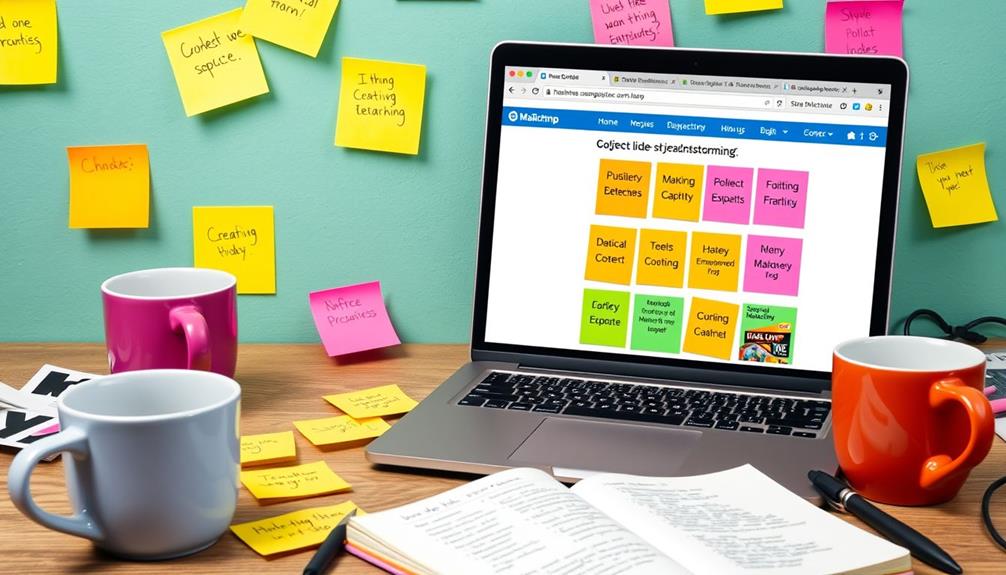
Crafting compelling subject lines is essential for grabbing your audience's attention and boosting open rates.
By personalizing your subject lines and incorporating urgency or FOMO, you can greatly enhance engagement with your emails.
Additionally, the insights from utilitarian thinkers' declarations can guide you in balancing individual preferences with collective audience appeal.
Let's explore how these strategies can transform your email campaigns.
Importance of Subject Lines
A compelling subject line can make all the difference in your email campaign's success. Subject lines are your first impression, and they need to grab attention quickly. Ideally, keep them to no more than 9 words or 60 characters to maximize open rates. You want your audience to feel compelled to click.
Consider exploring best websites to earn money online for inspiration on catchy phrases that resonate with your target audience.
Don't underestimate the power of personalization. Including both first and last names in your subject lines can double your open rates, making your emails considerably more engaging. Additionally, creating urgency or a sense of FOMO (fear of missing out) can effectively enhance reader engagement, prompting immediate action.
Mailchimp's advanced features, including AI analysis, can help refine your subject lines by suggesting ideal word counts, punctuation, and even emoji usage.
But don't stop there; A/B testing different subject lines is vital. By experimenting with variations, you can learn what resonates best with your audience based on their behavior and preferences.
Ultimately, your subject lines are the gateway to your content. Invest time in crafting them, and you'll see the impact on your overall email campaign effectiveness.
Personalization Techniques
Personalization techniques can transform your email subject lines into powerful tools for engagement. By crafting subject lines that are concise—ideally no longer than 9 words or 60 characters—you enhance readability and improve open rates. One of the best strategies is to personalize the subject line with both the first and last name of the recipient. This can double the chances of them opening your email.
Additionally, leveraging data-driven insights can help you identify which keywords resonate most with your audience, consequently enhancing content relevance and authority.
Consider the emotions you want to evoke; here are some ideas:
- Curiosity: Make them wonder what's inside.
- Connection: Show that you know them personally.
- Excitement: Create anticipation for what's to come.
For Mailchimp users, utilizing AI features can help analyze your subject lines for ideal word count, punctuation, and even emoji use, leading to better performance.
A/B testing different subject lines is also vital, allowing you to refine your approach based on actual user behavior. This guarantees your messaging resonates with your audience and drives engagement.
Urgency and FOMO Strategies
Creating a sense of urgency in your email subject lines can be a game-changer for engagement. By incorporating phrases like "Last Chance!" or "Sale Ends Tonight!", you tap into FOMO, prompting subscribers to act quickly.
Subject lines that feature time-sensitive language, such as "Only 24 Hours Left," encourage immediate responses, effectively boosting your click-through rates. Additionally, as the demand for digital marketing strategies grows, understanding user behavior and integrating insights from AI software engineer jobs can enhance your email effectiveness.
Personalization also plays an essential role. Including the recipient's first and last names can double your open rates, making your urgency feel more relevant and direct. You want your subscribers to feel like they're missing out on something tailored just for them.
Don't forget the power of A/B testing! Experiment with different urgent subject lines to see which ones resonate best with your audience. This approach leads to improved engagement metrics over time.
Lastly, utilize Mailchimp's AI tools to optimize your subject line length and phrasing, keeping them within the recommended 9 words or 60 characters. This guarantees your urgency and FOMO strategies hit hard and fast, capturing attention in crowded inboxes.
Start crafting compelling subject lines today to elevate your email campaigns!
Timing Your Emails Effectively
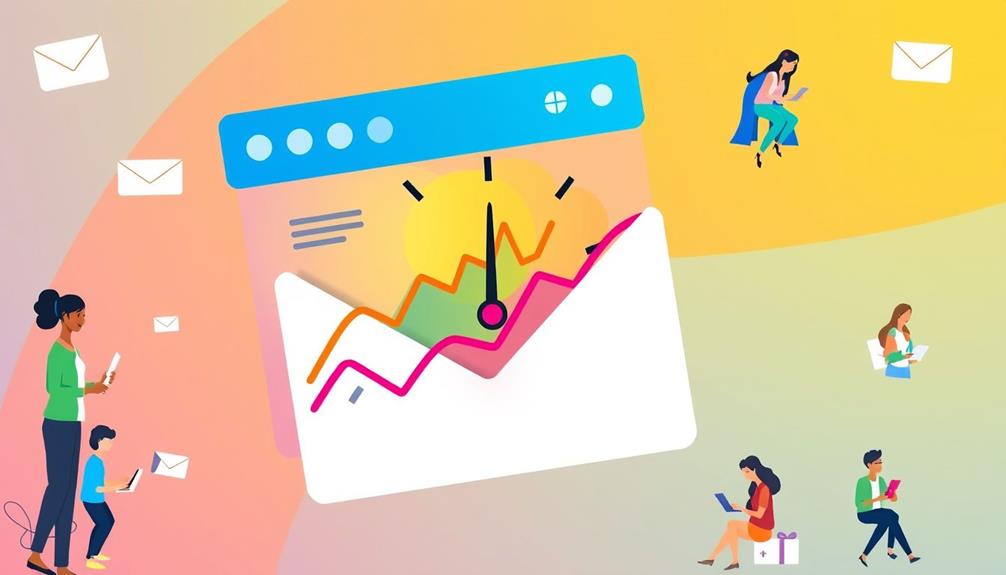
Timing your emails effectively can make a significant difference in engagement rates. By leveraging Mailchimp's Send Time Optimization feature, you can use data science to pinpoint the best times to reach your audience. This email marketing tool helps enhance your open and click-through rates, ensuring your messages land in inboxes when your audience is most receptive.
Additionally, understanding astrology's influence on personality traits can provide insights into your audience's preferences, potentially guiding your timing strategy.
To achieve the best results, consider these strategies:
- Analyze website analytics to identify peak traffic times, so you send emails when engagement is highest.
- Test different send times continuously, as engagement metrics can vary across demographics and industries.
- Pay attention to social media activity; it can reveal when your audience is most active and help fine-tune your timing.
Studies show that emails sent on Thursdays and Fridays generally see better open rates, making these days prime for targeted campaigns.
Optimizing Email Content

When optimizing your email content, focus on making it skimmable and engaging. Incorporating elements like clear financial terms can enhance understanding and retention.
Use clear headings, bullet points, and effective calls-to-action to guide your readers toward the desired actions.
Skimmable Content Design
A well-designed email can greatly boost reader engagement, and one of the keys to achieving this is by making your content skimmable. By utilizing skimmable content design, you can enhance readability and make it easier for your recipients to absorb key information quickly.
Use short paragraphs, bullet points, and clear headings to break up your content. Incorporating advanced mixing techniques can also help elevate the overall quality of your emails and guarantee your messaging resonates with your audience.
Consider these strategies to evoke emotion and draw readers in:
- Highlight key points that resonate with your audience.
- Incorporate relevant imagery to create visual interest.
- Maintain consistent typography to establish professionalism.
These elements can appreciably increase the likelihood that recipients will engage with your emails and drive higher conversion rates.
Additionally, don't forget to utilize buttons for clear calls to action, guiding your readers towards the desired interactions.
To continuously refine your approach, perform A/B testing with different content layouts and styles, confirming you're optimizing based on performance metrics.
Effective Call-to-Action
One of the most important aspects of your email content is the call-to-action (CTA). Effective calls-to-action should be clear, concise, and visually distinct, guiding your readers towards desired actions like clicking a link or making a purchase.
In the world of digital marketing, understanding affiliate marketing insights can also enhance your CTA strategies. Use action-oriented language in your CTAs, such as "Get Started" or "Join Now," to boost click-through rates by creating a sense of urgency.
A/B testing different CTA placements and designs can help you discover which options yield the highest engagement and conversion rates. Experiment with varying colors, sizes, and positions within your emails to see what resonates best with your audience.
Don't hesitate to include multiple CTAs, but make sure they're not overwhelming; this can cater to different user preferences and enhance engagement.
Leverage Mailchimp's analytics tools to track your CTA performance. These insights will help you understand which phrases and designs work best, allowing you to refine your strategy over time.
Personalization and Segmentation Techniques

Effective email campaigns thrive on personalization and segmentation techniques that cater to individual preferences.
By integrating strategies from design thinking principles, you can greatly enhance engagement rates by tailoring your content beyond just using a recipient's name.
With Mailchimp's effective tools, you can segment your audience into distinct groups based on demographics, purchase history, and engagement levels. This targeted messaging can boost your open rates by up to 14%.
Here are a few emotions you can evoke through effective personalization and segmentation:
- Belonging: Make your audience feel like they're part of a select group.
- Excitement: Offer tailored content that resonates with their interests.
- Trust: Show that you understand their needs through personalized recommendations.
Automation for Efficient Campaigns
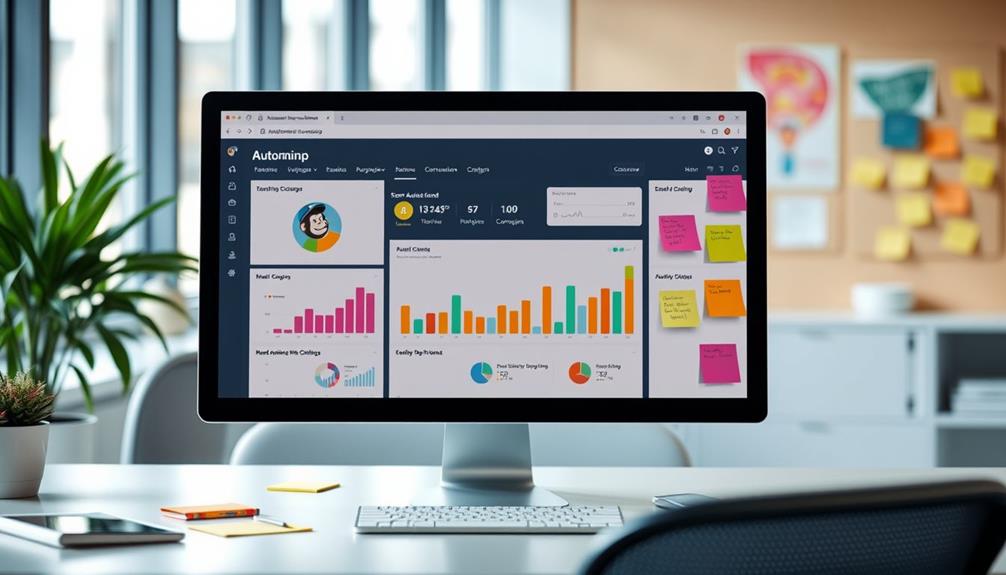
With Mailchimp's automation, you can guarantee timely email delivery that keeps your audience engaged.
Implementing re-engagement campaigns becomes effortless, allowing you to reconnect with inactive subscribers.
This streamlined approach not only saves you time but also boosts your overall campaign effectiveness.
Timely Email Delivery
Timely email delivery is essential for maximizing the impact of your campaigns, and Mailchimp's automation features make it easy to achieve. With tools like Send Time Optimization, you can schedule your emails to hit inboxes at the perfect moment, guaranteeing your audience is more likely to engage. This feature analyzes historical engagement data, so you can trust that your emails land when your subscribers are most active.
Consider how timely email delivery can transform your campaigns:
- Welcome new subscribers with immediate relevance.
- Recover lost sales through targeted follow-ups.
- Build lasting relationships by engaging at the right time.
Automated workflows are another powerful feature. They allow you to send timely welcome emails as soon as someone subscribes, or trigger messages based on user behavior, like product views or abandoned carts. This not only increases the chances of conversions but also helps maintain a connection with your audience.
Regularly testing and refining these automated sequences can lead to continuous improvements in your engagement metrics, driving better campaign performance over time.
Embrace these advanced features to guarantee your emails resonate with your audience when it matters most.
Re-engagement Campaign Strategies
Re-engagement campaigns can breathe new life into your email list by targeting inactive subscribers and drawing them back to your brand. With Mailchimp, you can automate these campaigns to guarantee that personalized messaging reaches those users who need a little nudge.
By utilizing behavioral targeting, you can trigger re-engagement emails based on specific actions—such as recent product views or abandoned carts—making your outreach more relevant.
To further enhance your strategy, A/B testing tools in Mailchimp allow you to compare different subject lines and content. This way, you can identify which elements resonate most with your audience, refining your efforts for better results.
Don't forget the power of segmentation; tailoring your re-engagement campaigns to specific groups increases the chances of recapturing their interest.
Incorporating special offers or incentives in your re-engagement emails can lead to impressive conversion rates—up to 170% higher, according to industry studies.
Analyzing Campaign Performance
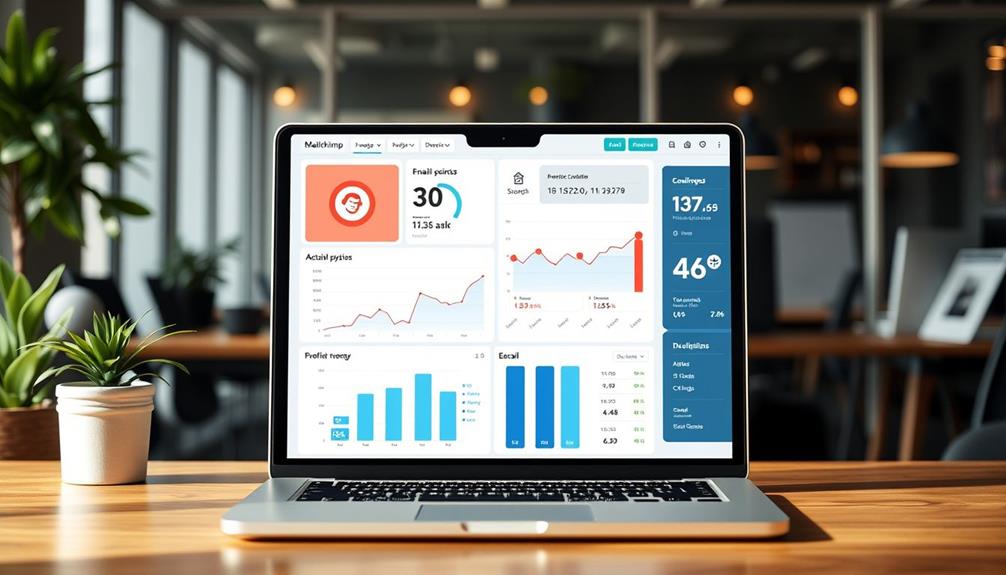
Analyzing campaign performance goes beyond just checking numbers; it's about understanding how your audience interacts with your emails. With Mailchimp's extensive analytics dashboard, you can explore key metrics like open rates, click-through rates, and subscriber growth. These insights help you evaluate the effectiveness of your campaigns.
By utilizing Mailchimp's reporting tools, you can track engagement metrics over time, identifying trends that inform your future strategies. For instance, A/B testing allows you to experiment with different subject lines and content variations, revealing what truly resonates with your subscribers.
Consider these emotional triggers as you analyze your data:
- The thrill of seeing your open rates soar!
- The satisfaction of improving your click-through rates.
- The pride in growing your subscriber list.
Benchmarking your performance against industry standards, like good open rates ranging from 15% to 25%, gives context to your results.
Plus, real-time feedback empowers you to make immediate adjustments, fostering a cycle of continuous improvement in your email marketing strategies. Embrace these tools to transform raw data into actionable insights that enhance your campaigns.
Best Practices for Email Marketing

Successful email marketing often hinges on implementing best practices that resonate with your audience. Start by crafting compelling subject lines that are no longer than 9 words or 60 characters; these are critical for improving open rates and engagement.
Next, utilize segmentation to tailor your messages based on demographics, purchase history, and engagement levels. This can greatly boost both open and click-through rates. You can also optimize send times by analyzing website traffic and social media engagement, and Mailchimp makes it easy with its Send Time Optimization feature.
Keep your email list clean and maintain it regularly to reduce bounces and unsubscribe rates. This guarantees your campaigns reach engaged subscribers.
Here's a quick overview of essential best practices:
| Best Practice | Description |
|---|---|
| Compelling Subject Lines | Limit to 9 words or 60 characters |
| Segmentation | Tailor messages to demographics and engagement |
| Clean Email List | Regularly maintain to reduce bounces |
A/B Testing for Improvement
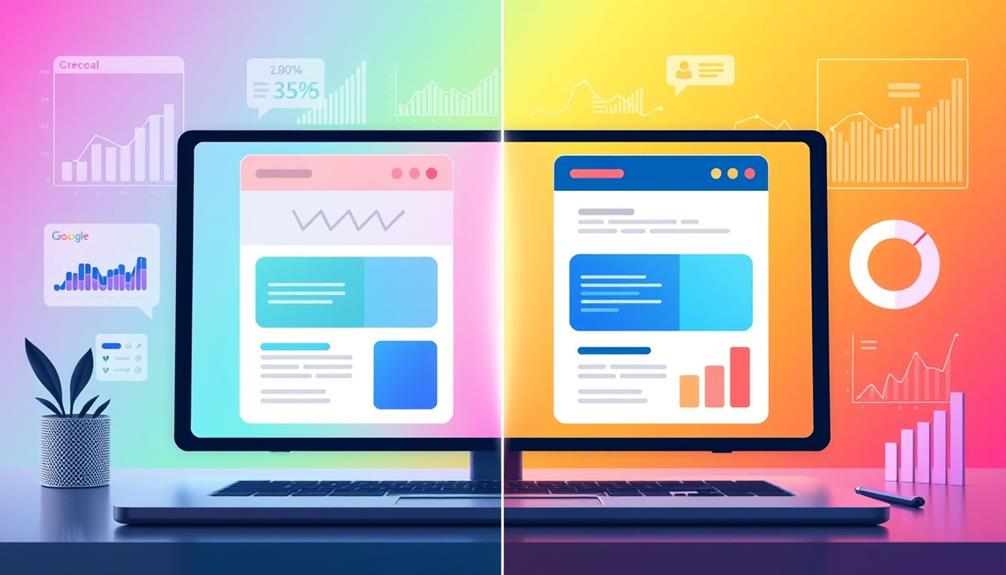
When it comes to enhancing your email campaigns, A/B testing is a powerful tool you shouldn't overlook. With Mailchimp, you can test up to three variations of your campaign, including subject lines, content, and send times. By analyzing open and click rates, you can gain valuable insights into what truly resonates with your audience. This knowledge allows you to optimize email content for future campaigns, greatly boosting engagement.
Regularly conducting A/B tests can lead to impressive results, such as:
- Increased open rates that capture attention
- Higher click-through rates that drive action
- Tailored content that speaks directly to your audience's needs
Studies show that optimized subject lines alone can enhance open rates by 20% or more. Mailchimp's built-in reporting tools make it easy to compare results, so you can make data-driven decisions for your email strategies.
Integrating Mailchimp With Other Tools
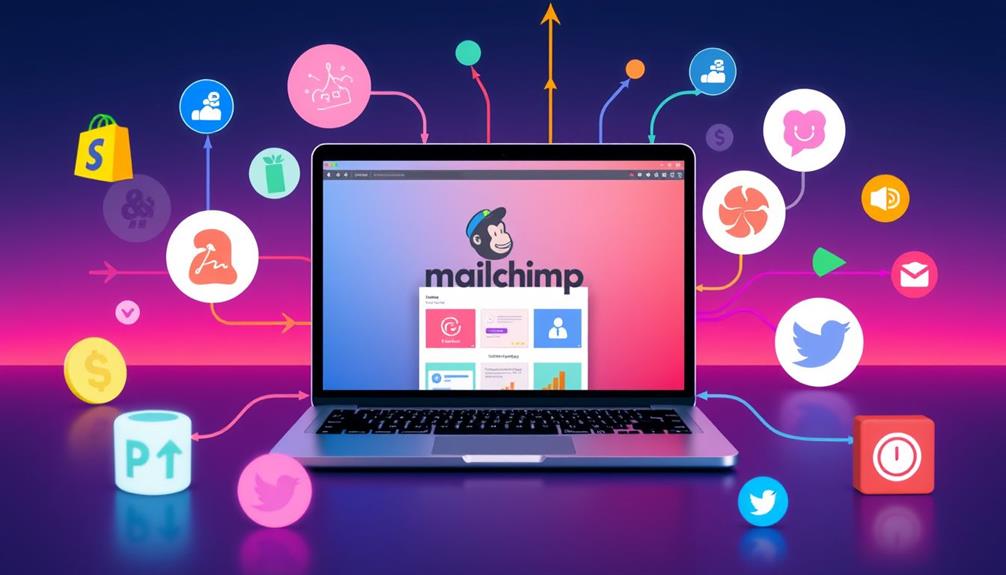
Mailchimp's integration capabilities can greatly enhance your marketing efforts by connecting with various platforms like Shopify, WordPress, and Salesforce. By synchronizing customer data across these platforms, you can create more effective marketing strategies tailored to your audience's preferences.
Integrating Mailchimp with social media platforms streamlines ad management, allowing you to run targeted campaigns directly from your Mailchimp account. This boosts your reach and drives engagement, making your email campaigns more impactful.
If you're in e-commerce, Mailchimp's integrations help track customer purchases and behaviors, enabling you to segment your audience effectively. You can then personalize your email campaigns based on shopping habits, leading to higher conversion rates.
For those with unique requirements, Mailchimp's API allows developers to create custom integrations that cater to specific business needs, ensuring a personalized marketing experience.
Additionally, with Mailchimp's Zapier integration, you can automate workflows by connecting Mailchimp with over 2,000 other apps. This enhances productivity and efficiency, giving you more time to focus on refining your marketing strategies.
Embrace these integrations to truly optimize your email campaigns.
Frequently Asked Questions
How to Maximize the Use of Mailchimp?
To maximize your use of Mailchimp, segment your audience effectively, automate emails for timely delivery, A/B test your content, optimize send times, and regularly analyze your campaign metrics to enhance future strategies.
What Are the Best Practices for Mailchimp Emails?
To create effective Mailchimp emails, you should A/B test your content, keep it visually appealing, personalize messages, utilize automation for sequences, and regularly analyze performance metrics to refine your strategy and boost engagement.
How Do I Make Mailchimp Email Better?
To make your Mailchimp emails magnificent, master the magic of A/B testing, segment your subscribers strategically, and synchronize send times. Also, sprinkle in stunning visuals, and scrutinize stats for smarter, more successful campaigns.
How to Optimise an Email Campaign?
To optimize your email campaign, experiment with A/B testing, segment your audience for tailored content, utilize send time optimization, clean your subscriber list regularly, and monitor analytics for data-driven improvements and engagement insights.
Conclusion
In the world of email marketing, mastering Mailchimp's advanced features can transform your campaigns. It's not just about sending emails; it's about creating connections. By leveraging personalization, timing, and data analysis, you can craft messages that resonate with your audience. Remember, the truth is that effective email marketing isn't just about numbers; it's about understanding your subscribers' needs. So, embrace these strategies, and watch your engagement soar—because meaningful communication is what truly drives success.










